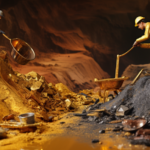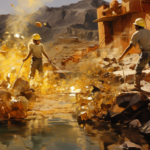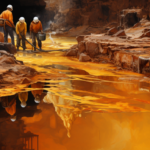Gold, with its gleaming allure and historical significance, has captivated humanity for centuries. It has been used for currency, jewelry, and as a symbol of wealth and power. However, the process of extracting gold from the Earth has significant environmental consequences. This article explores the environmental impact of gold mining, shedding light on the challenges and efforts to mitigate its effects on our planet.

The Gold Rush and Environmental Impact
The first major gold rush in the United States occurred in 1848 when gold was discovered at Sutter’s Mill in California. The promise of wealth drew thousands of prospectors, miners, and settlers westward. This mass migration led to rapid deforestation, soil erosion, and pollution of rivers and streams. The environmental cost of this gold rush was immense, and it set a precedent for the environmental consequences of gold mining that would follow in other regions.
Modern Gold Mining Methods
Modern gold mining techniques have evolved considerably since the days of the California Gold Rush. Today, gold is extracted using advanced technologies, including open-pit mining, underground mining, and heap leaching. Each method has its own environmental impacts:
1. Open-Pit Mining: This method involves removing large quantities of earth to reach the gold ore. While efficient, it results in extensive land disturbance, habitat destruction, and soil erosion.
2. Underground Mining: Underground mining can be less environmentally disruptive than open-pit mining, but it still poses risks, including subsidence, groundwater contamination, and waste disposal.
3. Heap Leaching: Heap leaching is a method for extracting gold from low-grade ores by stacking them into a heap and using chemical solutions to leach out the gold. It can result in the release of toxic chemicals into the environment if not managed properly.
Environmental Challenges of Gold Mining
1. Deforestation: Clearing large areas of forests to make way for mining operations not only destroys vital ecosystems but also contributes to climate change by reducing carbon sequestration.
2. Soil Erosion: The removal of vegetation and topsoil during mining can lead to soil erosion, which can degrade farmland, disrupt aquatic ecosystems, and cause sedimentation in water bodies.
3. Water Pollution: Mining operations often require the use of chemicals like cyanide and mercury to extract gold. These substances can leach into nearby water sources, contaminating them and posing risks to aquatic life and human health.
4. Habitat Destruction: Gold mining can disrupt fragile ecosystems, threatening wildlife habitats and endangering species. This habitat loss can lead to the decline or extinction of native plants and animals.
5. Air Pollution: Dust and emissions from mining equipment and vehicles can contribute to air pollution, affecting both local and regional air quality.
6. Toxic Waste: The waste generated during gold extraction, known as tailings, can contain hazardous substances like cyanide and heavy metals. Proper management and containment of tailings are critical to prevent environmental contamination.
Mitigating the Environmental Impact
Efforts to address the environmental consequences of gold mining have gained momentum in recent years. Various strategies and technologies are being employed to minimize the industry’s footprint:
1. Responsible Mining Practices: Mining companies are increasingly adopting responsible practices, including reforestation, soil conservation, and the use of less toxic chemicals in gold extraction.
2. Waste Management: Improved tailings management, including the construction of secure containment facilities, helps prevent toxic substances from entering the environment.
3. Water Management: The industry is focusing on water recycling and treatment to reduce water consumption and minimize pollution of water sources.
4. Environmental Regulations: Governments and international organizations are enacting stricter environmental regulations to hold mining companies accountable for their impact on ecosystems.
5. Restoration and Rehabilitation: Efforts are underway to rehabilitate mining sites once they are no longer in use. This can involve recontouring the land, replanting native vegetation, and restoring natural water flow.
6. Technology Advancements: Innovations in mining technology, such as cleaner extraction methods and improved waste management techniques, are helping reduce the environmental footprint of gold mining.
The Role of Certification and Transparency
Certification programs, such as the Responsible Gold Standard and the Fairmined Initiative, aim to promote ethical and environmentally responsible gold mining practices. These programs set standards for social and environmental responsibility, providing consumers with assurance that their gold comes from sources committed to sustainability.
Transparency is also playing a crucial role in promoting responsible gold mining. The ability to trace the origin of gold through blockchain technology and certification schemes enables consumers to make informed choices and support environmentally conscious mining operations.
The Importance of Sustainable Practices
Sustainable gold mining practices are essential to strike a balance between the economic benefits of gold production and the preservation of our planet’s ecosystems. The adoption of sustainable practices not only reduces the environmental impact but also contributes to the long-term viability of the gold mining industry.
Conclusion
Gold mining has a rich history and continues to be a significant economic activity worldwide. However, the environmental consequences of gold mining cannot be ignored. The industry faces challenges related to deforestation, soil erosion, water pollution, habitat destruction, and more.
Efforts to mitigate these impacts through responsible mining practices, improved waste management, and environmental regulations are essential. Additionally, certification programs and transparency initiatives play a vital role in promoting ethical and sustainable gold mining.
As we continue to appreciate the beauty and value of gold, it is crucial to ensure that the process of extracting it from the Earth is conducted in a manner that respects and preserves the natural world for future generations.



